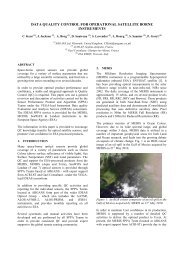SMOS L2 OS ATBD - ARGANS
SMOS L2 OS ATBD - ARGANS
SMOS L2 OS ATBD - ARGANS
You also want an ePaper? Increase the reach of your titles
YUMPU automatically turns print PDFs into web optimized ePapers that Google loves.
86<br />
ICM-CSIC<br />
LOCEAN/SA/CETP<br />
IFREMER<br />
<strong>SM<strong>OS</strong></strong> <strong>L2</strong> <strong>OS</strong><br />
Algorithm Theoretical<br />
Baseline Document<br />
4.4.1.3. Error budget estimates (sensitivity analysis)<br />
Doc: SO-TN-ARG-GS-0007<br />
Issue: 3 Rev: 9<br />
Date: 25 January 2013<br />
Page: 86<br />
In Camps et al., 2004, authors observe that the uncertainty of the brightness temperature<br />
sensitivity to wind speed is on the order of 0.1 K/(m/s) for all incidence angles, when using<br />
the model only dependent on WS. Therefore, for WS=10 m/s, the uncertainty of the<br />
brightness temperature Tb is about 1 K. Taking into account the brightness temperature<br />
sensitivity to SSS (0.35-0.8 K/psu at V-pol, and 0.20-0.6 K/psu at H-pol), it translates at 10<br />
m/s into a ∆SSS within 1.2-5 psu.<br />
4.4.2. Practical considerations<br />
4.4.2.1. Calibration and validation<br />
Roughness model 3 will be validated comparing <strong>SM<strong>OS</strong></strong> SSS retrieved maps with this<br />
roughness model with SSS maps created with interpolated ARGO data.<br />
4.4.2.2. Quality control and diagnostics<br />
Because of its empirical derivation, the model’s accuracy will be degraded for exceptional<br />
geophysical conditions, such as winds above 15m/s and wave height above 8m, for which<br />
very few <strong>SM<strong>OS</strong></strong> observations are available.<br />
4.4.2.3. Exception handling<br />
There is no particular exception handling in the algorithm except if the following<br />
auxiliary data are not provided by the processor or exceed the ranges of the LUT:<br />
the wind speed, WS<br />
the significant wave height, Hs<br />
the incidence angles i at <strong>SM<strong>OS</strong></strong> pixel<br />
If one of the prior values of the retrieved geophysical parameters is out of the LUT range, or<br />
if any retrieved geophysical parameter goes out of LUT range during the retrieval, different<br />
flags (Fg_OoR_Rough_dim1, Fg_OoR_Rough_dim2, Fg_OoR_Rough_dim3,<br />
Fg_OoR_Rough_dim4) are raised. No extrapolation is done and the boundary value is taken.



